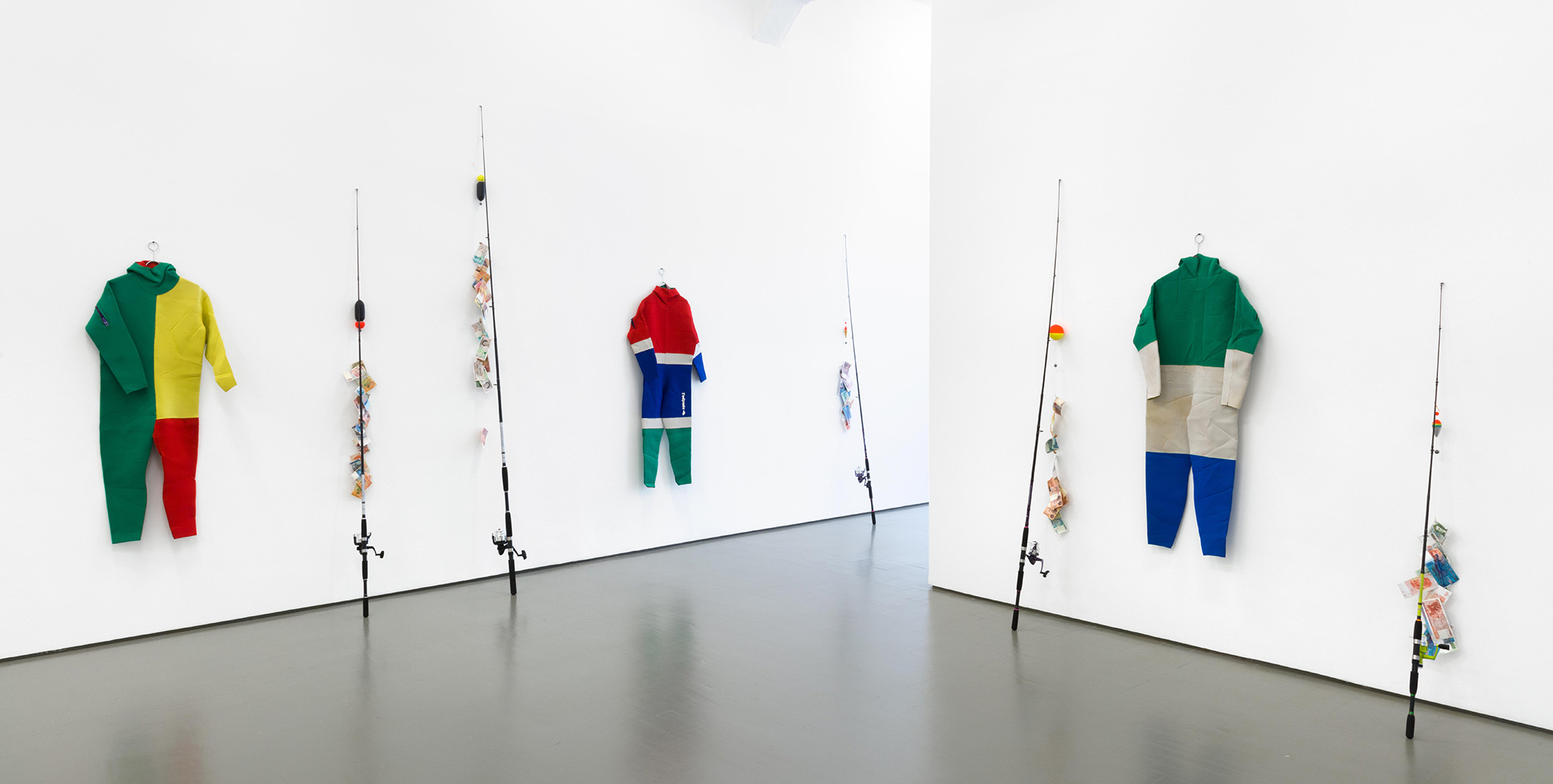Cape Town
18 February - 24 April 2021Meschac Gaba
Money, Money, Money

Meschac Gaba, Money, Money, Money, installation view with Atlantic, 2001
STEVENSON is pleased to present Money, Money, Money by Meschac Gaba. The works in this exhibition date from 1994 to 2016, and provide an overview of Gaba’s career-long investigation into the systems that create and uphold social, cultural and monetary value. Across installation, sculpture and prints, currency – whether in use, devalued or decommissioned – is used by the artist as a punchline, discursive tool and embellishment.
-
Informed by his experiences growing up in Benin – a socialist state until 1990 – and living between its capital of Cotonou and Rotterdam in the Netherlands, Gaba observes the structural principles that shape relations between Africa and the Western world. His constructions blur the line between art and the everyday to playfully elucidate both the fragility and totalising nature of systems of exchange.
About the artist’s early works, Okwui Enwezor has written:
In the context of the cataclysmic neo-liberal economic policies of the 1980s and 1990s imposed by the World Bank and the International Monetary Fund, and through the Structural Adjustment Programs that regulated the policies in African economies, the idea of value became even sharper. In these works of the early 1990s Gaba frames a concise connection between social value and cultural capital. He links devaluation to money, and money with the practical issues of survival in the midst of the chaos of illiberal impoverishment of masses of Africans. Nevertheless, value in Gaba’s framework is not predicated on the factionalised transformation of absence into presence. It has a concrete locus of power relations.
Dialogue (1994), a work pre-dating the artist’s time at the Rijksakademie, is characterised by a collage of decommissioned banknotes wrapped around a wooden sculptural form. This ‘relief painting’, created within a vernacular stereotyped as typically African, is a forebear of Gaba’s more recent works such as The Game – Raquette and The Game – Raquette badminton(2012), that also employ shredded CFA or Central Franc Africaine, the currency union of Francophone West African countries, as ‘texture and impasto’ or ‘modelling compound’. Gaba uses currency cosmetically for analytical ends, positioning these works as a questioning of the aesthetics of institutionalised rituals within the globalised marketplace, spanning recreational and visual traditions.
The tension between policy and practicality is further articulated in works such as Atlantic (2001). Comprising diving suits bearing the flags of some West, Central and East African states, as well as fishing rods and banknotes, the work invites a consideration of leisure, trade routes and exploratory journeys for conquest and survival, while bringing to focus the vulnerability of the absent human figure.
Colours of Cotonou, the installation central to this exhibition, was first shown at the Centre Culturel Français de Cotonou in Benin in 2007, and later at the Johannesburg Art Gallery. Kerryn Greenberg writes:
According to Gaba, he was inspired to create this installation after hearing a speech in which the president of Benin said ‘Cadre le cadre’ and ‘Les intellectuels, le cadre-vide!’ The French word Cadre has multiple meanings, including ‘frame’, ‘framework’ and ‘executive’ or ‘director’, and is often used to refer to the political elite. Intrigued by this dual meaning and the president’s railing against the ‘Intellectuals, the empty frame!’ - effectively, those in positions of power who represent the city, but do nothing for it - Gaba began to think about the anti-frame. The frame, like the museum, is a device that signals value. By framing nothing, or very little, the artist literally creates something unique out of the banal and gives equal prominence to positive and negative space.
Inspired by Benin’s culture of street trading, Gaba’s confetti-covered frames enclose found 'colours', drawing the audience to a recognition of the texture of the everyday, and highlighting the ubiquity of commodity. Bank or Economy, the most recent series in this exhibition, takes this further in its overt resemblance to market stalls. Featuring collections of banknotes, symbolic objects and raw materials of different kinds of worth, these intricate and immersive installations offer prescient critique of newly familiar terms such as ‘junk status’, underscoring the absurdity inherent to the theatre of value.
Mitsubishi 4X4 and Mercedes (2008) are included from Gaba’s Tresses series. This body of work was first conceptualised during a residency at PS1 Contemporary Art Centre in New York and has since been exhibited at the Studio Museum in Harlem, the World Bank and the Biennales of Havana, Gwangju and Sharjah. First modelled on buildings and then, in this second iteration, on motor vehicles, the series further questions the associative symbols of technological achievement and prosperity. Created in collaboration with hairdressers in Cotonou, these sculptures formed part of a six-hour masquerade procession through the city, a video of which will accompany them on the exhibition. About this documentary footage, capturing a range of responses ranging between fear and indifference, Gaba has noted, ‘fetishes are not an uncommon sight in Benin; it is the artist that people are unaccustomed to seeing in the street.’

